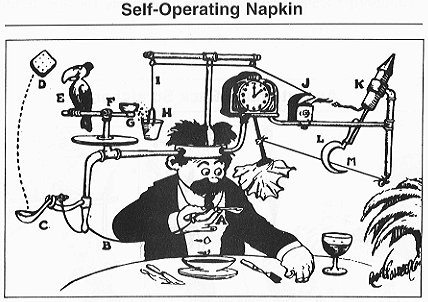In my last blog I was talking about building a Rube Goldberg Machine with Penn State's chapter of the Society of Hispanic professional Engineers (SHPE) but while talking to multiple people I realized they did not know what i was talking about. This led me to the conclusion that while mostly everyone has seen a Rube Goldberg Project, only a small percentage of people knew what one actually was. So I decided to post this blog to enlighten people as to what a Rube Goldberg Machine actually is and the background of how they began. I will also periodically post a few links to some videos of Rube Goldberg Machines that I found impressive.
https://www.youtube.com/watch?v=dvNrvfEQ-uw
 To start at the beginning, Rube Garrett Lucius Goldberg lived from 1883-1970 and throughout his life he was an accomplished cartoonist, engineer, and inventor. Goldberg had a sense of humor in his cartoons usually consisting of unnecessarily complicated contraptions that were built to perform a simple, everyday task. Goldberg had also received a Pulitzer Prize for his Political cartoons as well as becoming the namesake for the Reuben award, that the National Cartoonists Society presents to the Cartoonist of the Year.
To start at the beginning, Rube Garrett Lucius Goldberg lived from 1883-1970 and throughout his life he was an accomplished cartoonist, engineer, and inventor. Goldberg had a sense of humor in his cartoons usually consisting of unnecessarily complicated contraptions that were built to perform a simple, everyday task. Goldberg had also received a Pulitzer Prize for his Political cartoons as well as becoming the namesake for the Reuben award, that the National Cartoonists Society presents to the Cartoonist of the Year.
https://www.youtube.com/watch?v=HkXE8l5KzK4
 As previously stated, Rube Goldberg Machines consist of many complicated steps and chain reactions in order to perform very simple tasks that would have been easier to just do normally. There is not really any practical reason to create a Rube Goldberg machine for everyday use on easy tasks.These machines are usually only made for a comical reason or for contests and competitions. They are usually initiated by placing a ball at some point of the machine which can start the chain reaction of events in several different ways. Rube Goldberg Machine Competitions usually focus on the machines having a certain number of steps, how smoothly the steps are carried out, and in some cases if the contestants incorporated a central theme and if they made the apparatus aesthetically pleasing.
As previously stated, Rube Goldberg Machines consist of many complicated steps and chain reactions in order to perform very simple tasks that would have been easier to just do normally. There is not really any practical reason to create a Rube Goldberg machine for everyday use on easy tasks.These machines are usually only made for a comical reason or for contests and competitions. They are usually initiated by placing a ball at some point of the machine which can start the chain reaction of events in several different ways. Rube Goldberg Machine Competitions usually focus on the machines having a certain number of steps, how smoothly the steps are carried out, and in some cases if the contestants incorporated a central theme and if they made the apparatus aesthetically pleasing.
https://www.youtube.com/watch?v=_vacNFcN0is
Information and pictures from:
http://tvtropes.org/pmwiki/pmwiki.php/Main/RubeGoldbergDevice
http://en.wikipedia.org/wiki/Rube_Goldberg
http://goodcomics.comicbookresources.com/2009/03/19/comic-book-legends-revealed-199/





